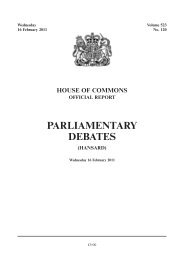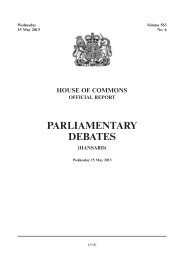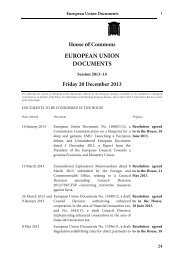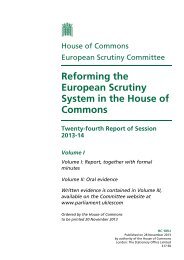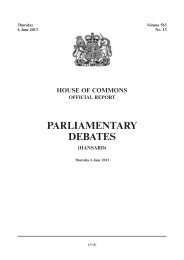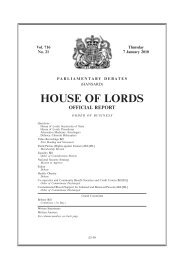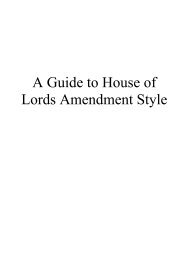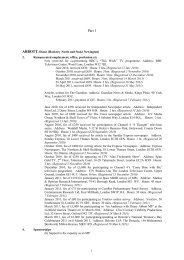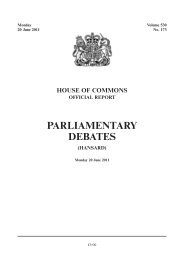Ticketing and Concessionary Travel on Public Transport - United ...
Ticketing and Concessionary Travel on Public Transport - United ...
Ticketing and Concessionary Travel on Public Transport - United ...
You also want an ePaper? Increase the reach of your titles
YUMPU automatically turns print PDFs into web optimized ePapers that Google loves.
<strong>Transport</strong> Committee: Evidence Ev 175<br />
What can be learned from the experiences of areas such as L<strong>on</strong>d<strong>on</strong> <str<strong>on</strong>g>and</str<strong>on</strong>g> Scotl<str<strong>on</strong>g>and</str<strong>on</strong>g> where smartcard technology<br />
is already in place?<br />
36. Experience from existing smartcard schemes has shown that smartcards can be both popular with<br />
the travelling public <str<strong>on</strong>g>and</str<strong>on</strong>g> eYcient in transport terms. The Department for <strong>Transport</strong> is currently c<strong>on</strong>ducting<br />
research reviewing existing schemes to underst<str<strong>on</strong>g>and</str<strong>on</strong>g> what has been achieved, <str<strong>on</strong>g>and</str<strong>on</strong>g> to provide advice for future<br />
implementati<strong>on</strong>s.<br />
37. L<strong>on</strong>d<strong>on</strong>’s Oystercard, which predates ITSO, is the largest smartcard system in the UK which now<br />
has 10 milli<strong>on</strong> cards. TfL’s strategy in winning public acceptance for Oyster has been to link its c<strong>on</strong>venience<br />
as a product with diVerential fares between paper <str<strong>on</strong>g>and</str<strong>on</strong>g> smart tickets. It is also widely available from both<br />
transport <str<strong>on</strong>g>and</str<strong>on</strong>g> n<strong>on</strong> transport outlets. TfL have exploited many eYciencies of the technology, reducing<br />
dem<str<strong>on</strong>g>and</str<strong>on</strong>g> <strong>on</strong> ticket oYce staV <str<strong>on</strong>g>and</str<strong>on</strong>g> crowding pressure in ticket halls, freeing up ticketing staV to help<br />
passengers out in the stati<strong>on</strong>.<br />
38. One of the reas<strong>on</strong>s for Oyster’s rapid success is that it was developed for a limited geographical area<br />
under the c<strong>on</strong>trol of a single Authority. It was developed for the Underground but now covers the TfL<br />
network. Experience has shown how important it is to interoperate with mainline rail ticketing. L<strong>on</strong>d<strong>on</strong> is<br />
central to the transport network, so any integrated ticketing soluti<strong>on</strong> should c<strong>on</strong>tinue to embrace rail<br />
because of the high proporti<strong>on</strong> of journeys which begin, end or pass through L<strong>on</strong>d<strong>on</strong>.<br />
39. Scotl<str<strong>on</strong>g>and</str<strong>on</strong>g> has opted for ITSO st<str<strong>on</strong>g>and</str<strong>on</strong>g>ard technology, preferring an open system (where there is a choice<br />
of suppliers) to bespoke systems. Choices <str<strong>on</strong>g>and</str<strong>on</strong>g> interoperability are seen as very important issues moving<br />
forward. The implementati<strong>on</strong> is being d<strong>on</strong>e entirely at the Scottish Executive’s expense. The Scottish free<br />
c<strong>on</strong>cessi<strong>on</strong> scheme generates about 160 milli<strong>on</strong> journeys per annum, with a budget for 2006–07 of £159<br />
milli<strong>on</strong>, <str<strong>on</strong>g>and</str<strong>on</strong>g> smartcards are seen as a key tool in helping to prevent fraud.<br />
40. The Department for <strong>Transport</strong> has worked closely with scheme promoters to learn best practise for<br />
smartcard deployment. The NoWcard scheme has been very successful in developing a partnership between<br />
a series of District Councils <str<strong>on</strong>g>and</str<strong>on</strong>g> Local Authorities which benefit from ec<strong>on</strong>omies of scale <str<strong>on</strong>g>and</str<strong>on</strong>g> agreed phasing<br />
of rollout across the bus fleet. Experience in Scotl<str<strong>on</strong>g>and</str<strong>on</strong>g> also showed we must plan a phased rollout of<br />
equipment <strong>on</strong> the bus fleet, allow time to ir<strong>on</strong> out bugs <str<strong>on</strong>g>and</str<strong>on</strong>g> gain support from bus operators. We supported<br />
academic research through the University of Newcastle <str<strong>on</strong>g>and</str<strong>on</strong>g> the University of Westminster which separately<br />
c<strong>on</strong>sidered the use of smartcard data to assess travel behaviour <str<strong>on</strong>g>and</str<strong>on</strong>g> the implicati<strong>on</strong>s for transport planning.<br />
A separate study, carried out by Newcastle University for DfT, produced a good practice guide for dem<str<strong>on</strong>g>and</str<strong>on</strong>g><br />
resp<strong>on</strong>sive transport services using telematics which c<strong>on</strong>sidered the potential to link smartcard technologies<br />
with dem<str<strong>on</strong>g>and</str<strong>on</strong>g> resp<strong>on</strong>sive transport services, helping to integrate them into the wider transport provisi<strong>on</strong>.<br />
41. We need to be careful to learn from existing schemes but not to fall into the trap of assuming what<br />
works in <strong>on</strong>e situati<strong>on</strong> will work else where. Early schemes were designed to be fit for purpose for the job<br />
in h<str<strong>on</strong>g>and</str<strong>on</strong>g> but may not be scaleable.<br />
Revenue Protecti<strong>on</strong> <str<strong>on</strong>g>and</str<strong>on</strong>g> The Powers of Ticket Inspectors<br />
Is the legal framework within which ticket inspectors functi<strong>on</strong> appropriate?<br />
42. We are not aware of any serious limitati<strong>on</strong>s in the powers within which ticket inspectors functi<strong>on</strong>.<br />
The Railway Byelaws (which came into operati<strong>on</strong> <strong>on</strong> 7 July 2005) have existed in a broadly similar form for<br />
many years, <str<strong>on</strong>g>and</str<strong>on</strong>g> the Government believes that these byelaws are both reas<strong>on</strong>able <str<strong>on</strong>g>and</str<strong>on</strong>g> fit for purpose. The<br />
byelaws include am<strong>on</strong>gst other things a requirement for passengers to buy a ticket before they travel<br />
wherever ticket facilities exist, <str<strong>on</strong>g>and</str<strong>on</strong>g> to give their name <str<strong>on</strong>g>and</str<strong>on</strong>g> address if asked by an authorised pers<strong>on</strong> (which<br />
might include a ticket inspector), if reas<strong>on</strong>ably suspected of breaching any of the byelaws. The byelaws<br />
require a pers<strong>on</strong> reas<strong>on</strong>ably believed to be in breach of any byelaw to leave railway premises if asked by an<br />
authorised pers<strong>on</strong>. If the pers<strong>on</strong> fails to desist or leave the premises, they may be removed using reas<strong>on</strong>able<br />
force. Many inspectors have been trained <strong>on</strong> the Police <str<strong>on</strong>g>and</str<strong>on</strong>g> Criminal Evidence Act, <str<strong>on</strong>g>and</str<strong>on</strong>g> where intent to<br />
avoid payment of their fare can be proven, passengers can be prosecuted under the bylaws or under secti<strong>on</strong><br />
5 of the Regulati<strong>on</strong> of Railways Act 1889. The Nati<strong>on</strong>al Rail C<strong>on</strong>diti<strong>on</strong>s of Carriage forms the basis of the<br />
c<strong>on</strong>tract between a passenger <str<strong>on</strong>g>and</str<strong>on</strong>g> the train operators, <str<strong>on</strong>g>and</str<strong>on</strong>g> these have been approved by the Secretary of<br />
State.<br />
43. Secti<strong>on</strong> 130 of the Railways Act 1993 (as amended) allows the Secretary of State to make regulati<strong>on</strong>s<br />
regarding the charging of financial penalties (“Penalty Fares”) to passengers unable to show a valid ticket<br />
when asked. The Railways (Penalty Fares) Regulati<strong>on</strong>s 1994 (SI 1994/576, as amended), made under the<br />
Act, in turn allowed the Rail Regulator to make Penalty Fares Rules. The functi<strong>on</strong> of making Rules was<br />
transferred first to the Strategic Rail Authority (SRA) by the <strong>Transport</strong> Act 2000 <str<strong>on</strong>g>and</str<strong>on</strong>g> then back to the<br />
Secretary of State by the Railways Act 2005. The Secretary of State has inherited the SRA’s Penalty Fares<br />
Rules 2002 <str<strong>on</strong>g>and</str<strong>on</strong>g> Penalty Fares Policy document.<br />
44. All train operators wishing to charge penalty fares must submit a penalty fares scheme to the<br />
Secretary of State for approval. Approval will be given if the scheme meets the st<str<strong>on</strong>g>and</str<strong>on</strong>g>ards set out in the policy<br />
document.



